The sea provides infinite possibilities for any preferences of fishermen, including feeder leger rig, float fishing, fishing with a spinning rod, catching fish, squid, octopus, cuttlefish. Each direction is diverse. adriaticnature will try to dwell on every single one.
There are way more small-sized fish than specimens weighing several dozen kilograms in the sea. But it doesn’t mean that it’s very easy to catch them. Light spinning tackle on the sea is a source of joy from exploring various fish species, fighting very strong sea rivals, regardless of their size, and simply endless pleasure from interacting with the sea.
There are a few people, who are competent in fishing with light spinning rods on the Adriatic Sea. Pavel Nagirnyi is one of them. He lives in the Czech Republic today. Nevertheless, he managed to get a grasp on the preferences of the Adriatic fish.

(Pavel Nagirnyi. Photo © Pavel Nagirnyi)
adriaticnature decided to deal with the “hardcore tackle” later and tried to figure out “ultralight” and “light” fishing instead.
Hello, Pavel! Thanks for getting around to this conversation. There are a lot of questions). Let’s start with the first and quite important one. Often, fishermen on the shores of the Adriatic Sea can’t carry around several “light” spinning rods for various reasons. One of them is “ultraultralight”, another is just “ultra”, and the third one is not ultra at all. Is there a “versatile” gear that enables you to fish with soft plastic lures on light jig heads, cast jigs and use a bombarda. You travel a lot. How did you work out this issue?
I didn’t raise the issue of choosing a rod for “ultralight” fishing on the sea from the get-go, since I, like every fisherman using spinning rods, I guess, had the so-called microjig (MJ) rods, with which we catch old familiar fish, such as perch, pike and zander in freshwater bodies. However, most of these spinning rods were originally developed and designed by manufacturers for fishing on the sea, for such “iconic” fishing styles as “mebaring” (Mebaru is a small sea fish (Sebastes inermis) from the Scorpaeniformes order; catching this fish is very popular in Japan and other Oriental countries) and “ajing” (Aji is a Japanese horse mackerel; catching it is very popular in Oriental countries as well).
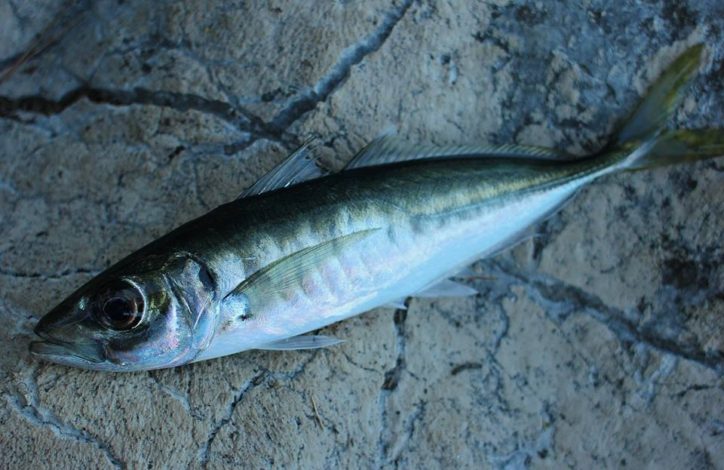
(Mediterranean horse mackerel. Photo by © Pavel Nagirnyi)
On my first trip to the seaside, I took a mebaru rod. It is a butt rod, the tip section of which is not very thin. It is fairly elastic, but quite tough at the same time. Truth be told, the most important thing for me in a spinning rod for fishing on the sea is the “tenacity” of its blank, since many fish strike the lure very carefully and therefore get hitched on the very edge of the mouth. In some fish species, the mouth structure itself promotes the hookpull: soft jaws of horse mackerels, small and toothy mouths of sea breams, long thin and hard “beaks” of garfish.
I think many fishermen will say: “Listen, dude, what is the purpose of the reel friction, anyway?” I’ve talked a lot with fishermen about this issue, mostly with those anglers, who like “extra-fast” spinning rods. They are the first ones, who have to rely on the reel friction brake, since spinning rods hardly extinguish the jerks of medium-sized fish.
Even the friction of the best reel is not a silver bullet. After hooking, many pelagic (and not only pelagic) fish species (sea breams, for example) can produce so much kinetic energy that your adjusted reel friction brake for the two hundred gram horse mackerel just won’t work. And at the other end of the tackle, the jig head hook will be unbent, broken, or even completely ripped off.

(Gilt-head seabream. Photo by © Pavel Nagirnyi)
That’s why, it’s very important that the rod extinguishes quick spurts of fish as best as possible. And when playing, the whole blank (instead of only its top) should be loaded as evenly as possible. If the rod is “fast” or “extra fast”, you can reduce the friction and run out a horse mackerel weighing two hundred grams. But if a half kilogram pompano or leerfish strikes your lure of the same weight, this situation can be compared with riding a sports bike up an arduous hill – you spin the pedals, and it stands still.
As far as I’m concerned, spinning rods with a tubular tip (“tubular” is a regular hollow tip, which in most cases has less flexibility than the “solid” tip with a monolithic insert of more flexible fiberglass or low-modulus graphite) for catching mebaru are more versatile for fishing on the Adriatic Sea. They are longer, usually 7’6”-9’1”, which is especially good for long-distance casting, since I have never caught pelagic predators at close range. They are softer and more elastic, often with fast or regular fast action. But not extra fast!
Moreover, they have a wider test – the weigh range of lures being cast, which enables to broaden their range in your boxes significantly. Using this rod, one can fish with soft plastic lures with jig heads, with small “creatures” – fantasy soft plastic lures imitating sea and other inhabitants, and soft plastic “worms” with the help of spaced rigs (Texas rig, Carolina rig, Drop shot rig, etc.). Besides, one can fish with small stickbaits, rigs with a bombarda for long-distance casting, for example, Tict M-Caro, jigs, spoon lures, etc. When the fisherman is on the rocks, it is more convenient to throw fish on the parapet of the embankment, moorings, or stones with a longer butt rod.

(Black scorpionfish. Photo by © Pavel Nagirnyi)
Of course, this is the case, when you don’t have the opportunity to take more spinning rods. If there is such an opportunity, two spinning rods will be more than enough for you. One is for fishing at short range, with 0-6 grams of dough, and the other is for fishing at long distances and with heavier lures, with top dough up to 12-15 grams.
I’ve never considered a travel rod for myself, but I can’t say it’s useless. Personally, I just feel uncomfortable fishing with a spinning rod, which has more than two knees. I’ll get off topic a little – I often went fishing by public transport with a casting single-part spinning rod, 213 cm long. Indeed, it’s not very convenient, but the fishing is rather impressive! Therefore, you are the ones to prioritize – fishing or the rest itself, and then make a choice. Anyway, you’ll have to pay about 50-80 euros to the airlines for the tube, but it’s not that much money to deprive yourself of a pleasure of fishing.
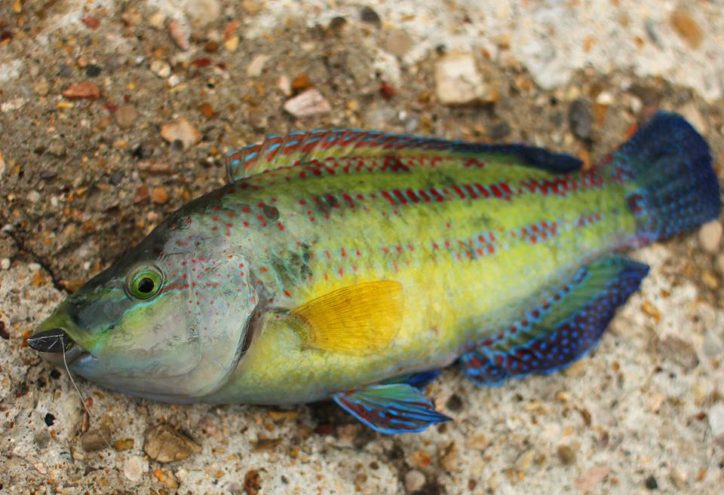
(East Atlantic peacock wrasse. Photo by © Pavel Nagirnyi)
It seems that we hunted down the question of spinning rods in general. But which reels should be used on the sea? Very often, anglers are afraid to take the reels they use at home on vacation, not least because they are afraid to make them worthless. What do you think about it?
As for the manufacturers of reels, everyone has to make his own decision concerning the brand he likes more. Each of us has different financial wealth, and this factor directly influences the decision when buying an expensive “top” model or a mid-range reel. If a person is ready to invest time and little money in professional maintenance of their reels, good second-hand reels can be bought, and the craftsman will fix everything gradually or immediately.
People’s fear to use their favorite reels on sea fishing is justified, as salt water damages any metal products. Even if you have a “top” reel labeled SW (salt water), it doesn’t mean that nothing will happen to it, in case of careless use in salt water. Reels with such a label are better painted, have protected (closed) bearings, different systems to prevent water from entering the mechanism, for example, Shimano brand based on different muffs and fillers (Coreprotect, X-Protect). Such systems protect the line guide roller and the main mechanism of the reel from the direct ingress of water inside, but there is no way to avoid the troubles caused by salt without doing anything with the reel.

(Garfishes. Photo by © Pavel Nagirnyi)
It is necessary to begin with the prevention of problems, that is, with preventive maintenance. At the very least, you should try not to cast the reel into the sea water and not to put it in the sand. It is more than desirable to wash the reel with running fresh water after fishing. And in any case, the “tech inspection” and “maintenance” should be carried out. Sooner or later, salt gets into the mechanism of the reel and begins to corrode metals and case cover. In some cases, “maintenance” must be carried out immediately – for example, if sand has accidentally got into the reel. It immediately begins to damage parts of the mechanism if you continue fishing, without having done maintenance and without removing sand from the mechanism of the reel.
As for the size of the reel, I’m one of those anglers who believe that it makes no sense to go below the size of 2500 according to Shimano classification. I had only one smaller reel, and I was really happy to get rid of it. Small size of the reel helps only with the weight, nothing else. On the sea, you need a versatile reel with a fairly capacious spool and the possibility of long-distance casting, so the size of 2500 according to Shimano classification is quite suitable for you, besides, you can animate any lures together with a spinning rod up to 12-15 grams without harming the mechanism.

(Salema. Photo by © Pavel Nagirnyi)
The next and, in my opinion, necessary detail is the smooth reel friction brake. I use reels with an under-spool knot system. For example, Shimano brand calls this system Rigit Support Drag. Some reel models have a muff in this place. It can be replaced with a bearing of the same size. If there is such a system, the reel spool doesn’t “float” with friction being significantly reduced. When you fish using thin fishing lines, you reel them out more smoothly during enemy’s jerks, which is very important if you have a bite of large fish.
So, you can use any reel. The main thing is to treat it carefully. After each sea fishing, it is advisable to wash it under running fresh water with a tightened friction brake and let it dry. And when you get back home, the craftsman or you (if you are competent enough) should carry out the maintenance. If you live by the sea and fish often, it’s better to do the maintenance once or twice a year so that your favorite reel could bring you joy for many years.
Fishermen often say: “It cost so much money that it should…” In fact, it shouldn’t. Everything breaks, collapses and gets damaged. Nothing lasts forever. Your expensive car or TV breaks down too. Why can’t a relatively cheap reel break down? And when you change the oil, filter, seasonal car tires, then why don’t you do exactly the same service, but for the reel, at the workshop, or put-replace spare parts?
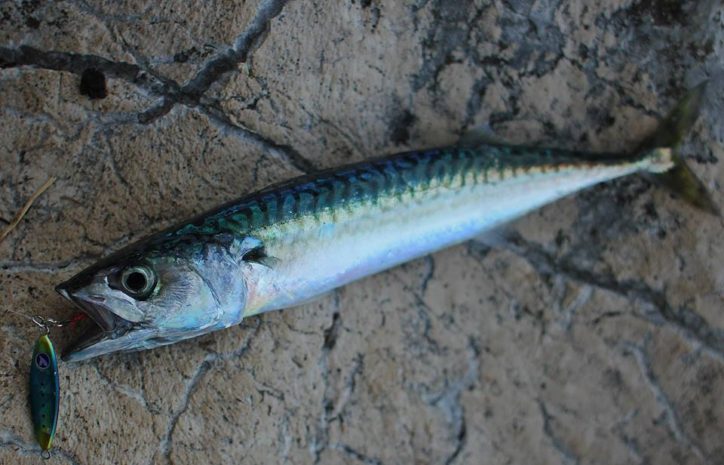
(Atlantic mackerel. Photo by © Pavel Nagirnyi)
Which braids or fishing lines, in your opinion, are better for fishing on the sea? Which fluorocarbon do you use?
Braid. Of course, you can fish with fluorocarbon lines or polyester. By the way, this is very popular in Japan. But most often anglers tend to use PE braid. At the modern fishing market, there are plenty of excellent products of Japanese brands, and I’m not going to recommend just one of them. As for my experience, after using the filament of the Japanese Sunline brand, I switched to the products of the Japanese brand Varivas. But I will remember the legendary, in my opinion, Sunline Rock Fish PE for a long time. Perhaps, this is one of the best “lines” I’ve ever caught fish with.
I use 4-core braid according to the Japanese numbering #0.4 for the “lightest” fishing. I used to use #0.3, but the braid one size thicker provides higher chances to succeed when large fish strike. Besides, chances to shoot off the lure are slimmer, with a weight close to the upper range of the rod test. A lot of thin eight-core braid options have occurred on the fishing market, but they cost much more than four-core ones.
I use a fluorocarbon “leader” for hooklinks produced by various manufacturers. In case of bottom fishing, I use Sunline FC Tornado V Hard HG, #1.25-0.185 mm and # 1.5-0.205 mm thick, as well as Duel H.D.Carbon #1.5-0.205 mm thick. I use Varivas FC Light Game #1.2-0.185 mm thick for fishing in the upper waters and using the M-caro bombardas.

(Pompano. Photo by © Pavel Nagirnyi)
Tell us, please, what should be the lure set of a fisherman catching fish with a spinning rod, who is going to devote his vacation on the sea to light rock fishing? And what about the lure set of a fisherman who doesn’t know which lure to start with, because their range is huge?
Indeed, there is a wide choice of lures. I would even say that the fishing market is overstocked with them. But, experience has proven that a few brands still have their own secrets and developments, which make them stand out from mass products.
Most often, I fish with soft plastic and metal lures, since they are the best, while searching for fish and setting the retrieve horizon. But, I use “plastic” as well. “Plastic” here means minnow-shaped plugs, topwater lures – poppers and walkers, and my favorite sinking bladeless plugs – stickbaits.
If we compare the catchability of lures in the sea “ultralight”, soft plastic lures are the best, then – metal jigs, and then – “plastic”.
Almost all fish of the Adriatic coast actively respond to soft plastic lures. If you take the lures of the three main forms (“slugs”, “worms” and “crustaceans”) with you, you can catch a large number of different representatives of the ichthyofauna. Sea breams, groupers, garfish, horse mackerels, scorpion fish, gobies and many other species won’t stay indifferent to them.
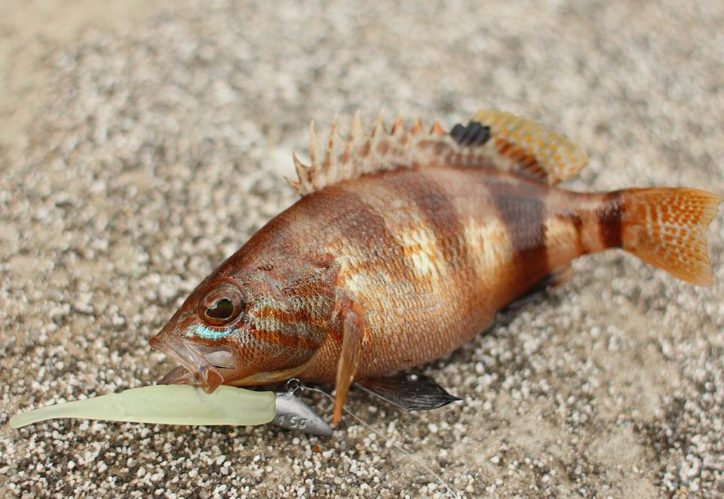
(Brown comber. Photo by © Pavel Nagirnyi)
Many sea soft plastic lures are often not that different from freshwater soft plastic lures, but they are painted differently, and, most importantly, they have a different resistance to the teeth of fish.
Pink, white, red, transparent and Glow are often used in the sea light spinning fishing. At the same time, these colors are not the most popular for freshwater fishing.
The “vitality” of soft plastic lures is not so important in fresh water, and in many cases the softest and not the most durable lures save fishing. On the contrary, this is a very important factor in the sea fishing. If you fish with soft fragile lures, something will be missing: either lures or nerves. Sea fish are very fast, aggressive and toothy, so often, one lure is not enough to finish the retrieve. And you have to replace lures constantly.

(Sand steenbras. Photo by © Pavel Nagirnyi)
I prefer the products of the Japanese Maria brand of all the soft plastic lures I’ve used. Their lures are made of a special material, which has the qualities that are very important to me, namely, softness and increased resistance to aggressive bites of sharp-toothed fish.
The second best in terms of catchability is the iconic Japanese Tict brand. The lures of this company are good for catching various fish species, although they are not as strong as the lures of the above-mentioned manufacturer Maria, therefore some fish manage to bite off and gnaw out pieces of their bodies.
And finally, the third Jackall brand is worth mentioning in my personal catchability rating, namely the lure called Peke Peke Long. This lure is good for catching the garfish. When catching this fish, I use this lure on a jig-head weighing 1.5-2 grams, and perform fast monotonous retrieve with short jerks. In most cases I use pink, orange-carrot and white shades of Glow lures, then – pink-transparent UV and transparent with silver glitter. The most commonly used lure size is 1.8” – 2.8” (45-70mm).

(Painted comber. Photo by © Pavel Nagirnyi)
Marukyu Power Isome, which is worth mentioning as well, is a very popular lure among fans of sea fishing. Personally, I don’t like it, because it attracts all living beings nearby, and it becomes difficult to catch an interesting fish because of the constant bite of very small fish. However, if your goal is to catch anything at any cost, this is exactly what you need. I was fishing with Marukyu Power Isome when the strong wind was blowing, when fish was biting only this lure, and if the bites happened, they were almost imperceptible. My four-year-old son caught his first fish with this lure. My wife and sister caught fish with these worms as well, although they had never held a spinning rod in their hands before.
In general, there are countless offers on the market, and you can pack a suitcase of soft plastic lures, but believe me, it’s not worth it.

(Annular seabream. Photo by © Pavel Nagirnyi)
In addition to the three brands that I mentioned, of course, I’ve caught fish with many other lures produced by various manufacturers. I try to take something new on each trip, in order to understand, to find the lure with the best catchability. But Maria, Tict and Jackall established themselves as leaders as regards fish and my bag with soft plastic lures so far.
The second type of lures is metal jigs. There is a wide range of jigs on the fishing market as regards manufacturers, form, weight, and color scale as well.
Jigs can be divided into the following three main types: “jig” with a center of gravity in the tail section or closer to the middle for fairly quick retrieves; “Slow jig”, which is a wide lure, which is falling slowly almost in a horizontal position due to the center of gravity located almost in the middle; and thin, so-called “slim Jig”, although nowadays some manufacturers add prefixes to their products “super slim Jig”. “TG Jig” (TG-Tungsten) is worth mentioning as well. It is a compact and heavy tungsten jig, which makes it very convenient to break through the headwind. It reaches the bottom quickly at great depths due to less resistance and its weight. Besides, it doesn’t drift so much.

(Leerfish. Photo by © Pavel Nagirnyi)
It’s hard to say that only one type or form has the best catchability. Probably, everything depends on what the fish will believe in, what will seem to be a target at the moment.
As for the weight and color of jigs. These lures weighing one gram to relative infinity and painted all sorts of colors are manufactured nowadays. The most popular and efficient metal jigs from my box are jigs weighing 5-7 grams for fishing in the coastal zone, and 9-15 grams – for long-distance casts when searching for predators at depths of up to 20 meters. The most efficient colors are “sardine” and silver.

(Common dentex. Photo by © Pavel Nagirnyi)
In the end, I want to say a few words about plastic lures. Why in the end? Because it’s not so easy to deal with them in “light” fishing. For me, at least. I managed to catch only a few medium-sized European basses and groupers with small minnows; small topwaters caught several half-kilogram leerfishes.
At the same time, I caught European bass, grouper, small-sized dentex, garfish, saddled bream and leerfish with small “sticks” – “stickbaits”. On the last fishing trip to Croatia solely, I caught more than a dozen of half kilogram leerfishes with Tict x Lucky Craft Wander 50 Lite. In general, this aesthetic type of lures has yet to be dealt with in more detail in “light” fishing, since in “hard” fishing, plastic tops and brings large sea predators quite regularly.

(Bluefishes. Photo by © Pavel Nagirnyi)
There are a lot of split shot options for soft plastic lures you were talking about. There are many shapes of jig heads as well. Moreover, there are split-shot, drop-shot, carolina, special sea developments – bullers, barakuris and others. Do different forms of jig heads make sense? If so, which ones are better than others? Is it worth experimenting with other split shots? Are bullers and barakuris efficient when fishing on the Adriatic Sea?
You’re right. A variety of jig heads and different split shot options outnumbers their amount of used in freshwater fishing.
Is it worth experimenting? Of course! It is more convenient to fish with certain jig heads, equipped with lures in the form of various crustaceans, the so-called “creature”, when retrieving at the bottom. Other jig heads are more convenient for fishing in the bottom, middle, and subsurface layers, the so-called “pelagic jigging”. The lightest heads, weighing only 0.2-0.6 grams, are good for catching horse mackerels and other fish purposefully in the upper waters with the help of a bombarda.

(Mediterranean horse mackerel. Photo by © Pavel Nagirnyi)
Until now, I have caught fish with many models of jig heads of such Japanese manufacturers as Decoy, Magbite, Cultiva, Shimano, Tict, Breaden, Xesta, Morigen, Junglegym and, on the last trip, I discover the Thyrty 34 Four brand.
As for the night bottom fishing with the “creature” lures, I liked Junglegym Sleeper Jig Head weighing 2-4 grams the most. The lure stands on this head at the bottom at about a 45-degree angle, resembling the natural position of the crustacean. The lure never falls on its side, while retrieving. It sways after each jerk-jump on a pause, resembling a living organism. I want to say that Sleeper Jig Head shape is perfect for using “crustacean” soft plastic lures, and right now I can hardly imagine anything better for this fishing method.
As for bottom fishing and fishing in the bottom layers during daylight, with more aggressive and faster retrieving, most often, I use Magbite Upper Cut Jig Head weighing 1.2-2 grams, Shimano Soare Skiphead 1.3-1.6 grams, and Decoy Rocket Plus 1.8-2.5 grams. In the first two cases, Magbite and Shimano, I use bigger lures, such as Maria Dart Squid 2”, Maria Action Fish 1.8”, Tict Briliant 2.5” and the like. In my opinion, Decoy Rocket Plus is more for crucian carps, and I use them with such lures as Maria Aji flutter 2.3”, Maria Slim crawler 1.8-2.3” and “volumetric” model Maria Clione 1.2-1.8”. Clione was the most efficient on this jig head.

(Dusky grouper. Photo by © Pavel Nagirnyi)
I don’t call to catch fish only with the above-mentioned soft plastic lures. By no means. I just want to tell you about the shape of the jig heads and the shape of the lures, which are the most efficient, when used together.
Jig heads of the Japanese brand Thyrty 34 Four Driver Head are the latest and newest in my box. I got them accidentally before traveling to Croatia. I was saying goodbye and talking to my friend near his car. He found Driver Head box in the trunk and showed it to me. I asked to take one, just to try it because I hadn’t caught with them before. A friend gave me the whole box and said that he didn’t need them. I couldn’t refuse.
In Croatia, I was catching horse mackerels with bombardas. Frequent failures made me put more and more lightweight jig heads, but little changed. It all continued until I tried Thyrty 34 Four Driver Head. And, surprise! I ran out of them. Imagine more than ten morning fishing trips – and not a single failure of the bite. The hook of this jig head pierced the mouth of a horse mackerel in its toughest parts, leaving no chance for it to escape.

(Common pandora. Photo by © Pavel Nagirnyi)
Texas rig and Carolina rig. The load is the same – a lead or tungsten bullet, but the designs are different. In case of Texas rig, the lure goes almost right behind the load. And in case of Carolina rig, the lure moves at the distance of the length of the hooklink from the load, and, if there is a current, it floats above the bottom, without touching it.
I use Texas rig more often, and Carolina rig – very rarely. Catching with these rigs mainly takes place at long distances, since it is more convenient to fish at close range with jig heads. When fishing with Carolina, you get many false bites, since the lure is mounted to the hooklink, it floats almost under zero gravity, and the fish attack it from different sides. The bite with Texas is clearer and more informative, the fish overtakes the lure, the blow is passed to the hand, and you manage to catch the predator.
With the Texas rig, I usually use small “creature” lures when fishing for groupers. Marukyu Power Isome worms are perfect for all other fish species. I managed to catch several specimens of wide-eyed flounder (I was longing to catch it so much for so long) with Power Isome. Grouper is often caught this way, but I haven’t caught this fish purposefully with the help of Texas yet, since there were not so many groupers in the places where my fishing on the Adriatic took place.

(Goldblotch grouper. Photo by © Pavel Nagirnyi)
Drop shot rig is another rig I rarely use when fishing on the sea. As far as I understand, it is necessary when you need to “wander” with the lure on a certain area of rocky bottom near boulders, or above the grass.
I want to tell you about one case as an example. I was fishing with my friend for river perch using the drop shot rig in the Czech Republic on the Elbe River. He was very surprised at the rate of catching I used. I call it “wandering”, meaning the lure keeps wandering around, without taking the load from the bottom. And then, I slightly move the lure, continuing the same algorithm of actions. It’s quite boring, but it has worked for “passive fish” perfectly. He was surprised. He was familiar with this fishing method. But he has never seen such a slow pace of retrieving.
In autumn of the same year, Taras, that was the name of my friend, went to Croatia, where he happened to fish in a large, shallow sea bay. It was not more than a meter deep there, the bottom was covered with dense aquatic vegetation, and occupied half the space to the surface. Remembering the drop shot rig and Keitech Sexy Impact 2.8” lure painted Hot Fire Tiger, with which I successfully caught perches on the Elbe that day, he made the same one and caught tons of European bass, weighing not more than a kilogram each. The fish was swimming in the grass and attacked the lure, jumping out of its depth. And despite the fact that the color of the lure was not marine at all, in this situation, with this feed, this method – drop shot rig – proved to be as good as it gets.
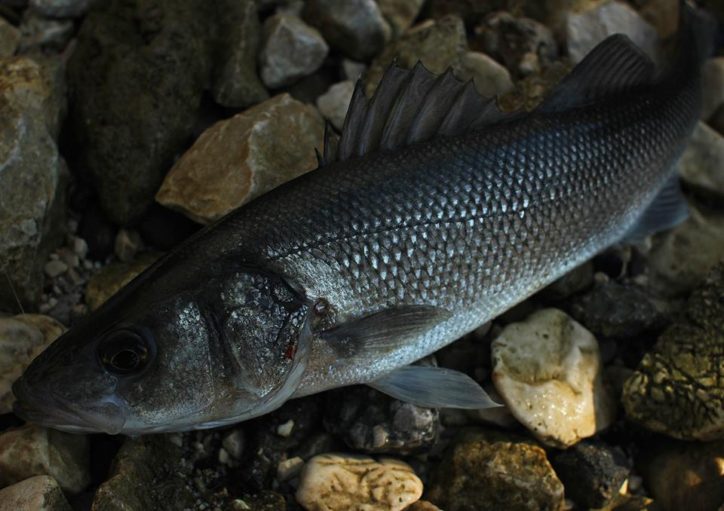
(European seabass. Photo by © Pavel Nagirnyi)
Bombardas. It is s separate topic for a separate article. I don’t have enough experience for such an article right now. The choice of bombardas on the fishing market is great, and so far I have caught fish only with the help of Tict M-Caro. Some people neglect this fishing method, saying something odd: “bombarda is not a “pure” spinning”. As far as I’m concerned, bombarda is just another type of split shot, with which you can cast a light lure relatively far. Moreover, bombardas help in fishing various layers of water in search of active fish. After all, there are floating (with neutral buoyancy) and sinking bombardas. So far the best result was shown by the following combination: Tict M-Caro N weighing 8 grams + Thyrty 34 Four Driver Head weighing 1 gram + Maria Aji flutter 2.3-2.8” of S\RG Glow color.
Bullers. It is an interesting option of sea split shots that is good at overcoming obstacles at the bottom. But it’s not a silver bullet. Bullers come off on hooks, like jig heads. But they cost more. I didn’t notice any super-advantages, applying them in fishing, so I’m not interested in them so much, but they are always in my box.

(East Atlantic peacock wrasse. Photo by © Pavel Nagirnyi)
Barakuris. I didn’t get barakuris at all. I think they need a vertical component, for example, fishing from the kayak is right where they belong. All my attempts to fish on the shore with split shots of the lures with the help of barakuris ended up in fuzzy ineffectual bites, and often the fish just lured the bait off the hook.
Split shot rig. I admit, I didn’t fish with it on the sea, as I probably didn’t find the right place, or it just didn’t occur to me, where such a rig would be more preferable than others. However, I always take weights for fishing with a split shot to sea fishing, feeling that someday I will use them.
I want to say a few words about the methods of lure retrieving. I should mention that I’m not a fan of high speed, or rather I don’t like to hurry when the situation doesn’t require it. The joy of the fishing process is the main thing for me. It is somewhat surprising to see how many anglers make some insane high-speed retrieves when fishing with sea “ultralight”, using the classic “jig” retrieves, which are often used when catching perch or zander.

(Little tunny or false albacore. Photo by © Pavel Nagirnyi)
It may seem strange to someone, however, judging by my experience, all these fast retrieves work much worse than the trivial steady retrieve of plastic lures or jigs. Not only speed pelagic fishes, for which movement is an integral part of their life, inhabit the sea. There are various bottom predators, which slowly follow the lure, and attack it only having believed in its realism.
In my opinion, seabreams are the most mistrustful sea predators. The larger they are, the more careful they are. I’ve often observed how sea breams follow soft plastic lures, carefully study it, without attacking it. And just after choosing the right pace of retrieving, it was possible to persuade the sea bream to bite.
When I understand that there are fish in the chosen “place”, but they don’t “eat”, I slow down the movement of the soft plastic lure and try to work more on the animation. Very often, when the fish shows at least minimal interest in the bait, the following maneuver brings good results: I stop the lure in the right place and start playing with the tip of the rod, promoting a series of short but sharp jerks, making the “worm” move on the jig head, almost without removing it. And only then, when biting becomes steady, and the fish bends the tip of the rod, I carry out the hooking.

(Mediterranean rainbow wrasse. Photo by © Pavel Nagirnyi)
This is what I wanted to say about mistrustful fish. But there are still frightened fish. As for me, I think they are the inhabitants of the crevices of the walls of the quays and embankments. These are mainly large gobies, scorpion fishes, small groupers, sea perches. If you aim at catching these cautious predators, the distance of the lure from the place of their “ambush” is very important. These fish need guarantees that after they grab their prey, they will immediately hide in their bunker until another larger predator eats them. It is necessary to retrieve the lure almost close to the walls of the piers and moorings. This is the only way you can provoke an attack of the “timid” ones.
“Timid” fish manage to impose their rules. Your confident hooking is not enough. You have to be ready for quick hooking, you won’t miss it, it’s aggressive. And your quick response is required. You shouldn’t miss a second. Otherwise, the enemy will swim into the crevices, and you will get nothing, or rather without the lure. Join the battle immediately. With a tightened friction. If you want to know your response rate – I suggest trying this type of fishing, gobies will tell you how fast you are.
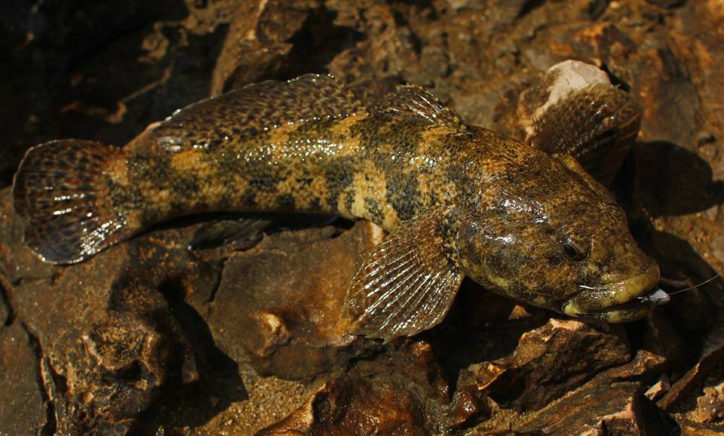
(Grass goby. Photo by © Pavel Nagirnyi)
And one more thing – “timid” fish are afraid even of the shadows. Your shadow will hinder you. Go as far from water as possible, if the sun is behind your back and check your response.
I’d like to say a few words about the fish that are well known to anglers. Horse mackerel and garfish.

(Mediterranean horse mackerel. Photo by © Pavel Nagirnyi)
Horse mackerel. Bombarda is a great helper. Fishing technique using bombardas is quite simple. Casting, short jerk, in order to exclude the possible overlap of the lure with a hooklink or filament. Next – steady and fairly fast retrieving with “draws” and pauses. If the fish doesn’t respond to the lure near the surface, I begin to look for a horizon where the fish can stand, and lower the lure a little with the help of a sinking bombarda, counting to myself (one-two-three- and so on), trying to understand at what “countable” depth the predator becomes active. Let’s take “ten”, for example. I will catch at this depth, making the retrieving in this layer of water.
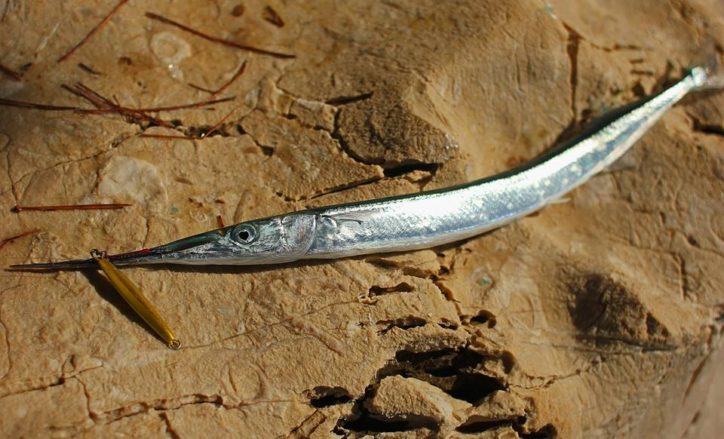
(Garfish. Photo by © Pavel Nagirnyi)
Garfish. I found two “working” approaches to it. The first one: soft plastic lure, which doesn’t have its own active game. Jig head, fast retrieving with short, and quite “strong” jerks. With such a technique, the lure is “wandering” in the water column, not much deviating to the sides. The other one: small stickbaits. If stickbait is thin, as, for example, Tict x Lucky Craft Wander 50 Lite, then, in my opinion, fast retrieving with frequent short jerks won’t leave a single Adriatic garfish indifferent to the lure. But, if the stickbait is quite voluminous, like Duo Tetra Works Yurameki, then it’s better not to rush and pull, the medium-fast steady retrieving is preferred.
I’d really like to continue the conversation, but there is too much information for one article, I think. Let’s take a break and continue to talk on the topic of “ultralight” on the pages of adriaticnature in a more specific and highly specialized way. And not only concerning this topic.
I want to bring the issue to a close. Accessories for fishing. In my humble opinion, every angler should have a special grip for fish. I use Dress Dino Grip. I’m confident and calm. There are alternatives on the market; of course, it’s up to you to choose.
A fishing towel is a very necessary thing! It is made of dense material. It can be fastened to the loop on the pants, bag, backpack with the help of a rivet. You can dry your hands before taking a camera or sandwich. I’ve been using a towel Sunline Towel TO-100 for several years now. I’m really satisfied.

(Common dentex. Photo by © Pavel Nagirnyi)
Don’t forget about the accessories. You want to catch a barracuda – you’ll have to wander in the twilight along the rocky shores. You’ll have to tie a fluorocarbon hooklink. You’ll need a high-quality head flashlight!
Convenient boxes, scissors, tweezers, lipgrip, knotting – I won’t continue to specify what makes your fishing comfortable and memorable for a lifetime. In my case, the lack of useful gear doesn’t make fishing more pleasant. It spoils it.
Experiment, friends! Sea fishing is not a couple of turns of the reel with a weight lead on other end of the tackle. It’s not theoretical chatter in Facebook groups. It’s not aliexpres – If you have the opportunity to run away from it – you’d better run. Read the right things. Draw the right conclusions. Buy the right tackle. Catch fish right!
The sea is older than us. But it will make any teenager with a spinning rod or a fishing rod fall in love with it.
I hope I could give you some useful advice. If not, don’t get angry. But, no matter how you respond to the article, in the near future, we will still figure out particularities. Bombardas as well. It’s relevant. Keep waiting. And, of course, good luck!